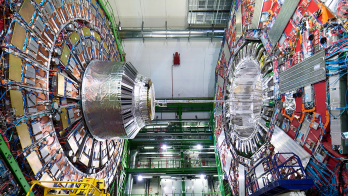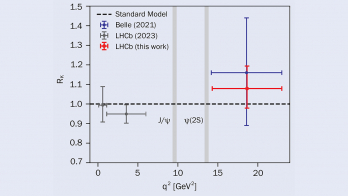Interest in CP violation continues today with studies of b hadrons and neutrinos.
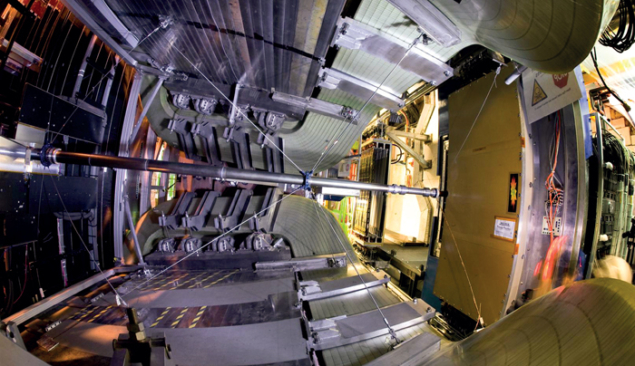
Image credit: CERN-PHOTO-0807022 – 01.
The observation of CP violation was first revealed to an unsuspecting physics community in July 1964 (“CP violation’s early days”). Since then, as figure 1 shows, interest in this puzzling phenomenon has grown significantly. So what is driving this interest and what remains to be studied?
One reason that the field remains so vibrant is the connection with the existence of our matter-dominated universe. As Andrei Sakharov showed in 1967, the absolute distinction between matter and antimatter provided by C and CP violation is – together with baryon number violation and a period of thermal inequilibrium – one of the necessary conditions to generate a net baryon asymmetry from an initially symmetrical state (Sakharov 1967). Moreover, because the Standard Model provides only a small amount of CP violation, and also constrains strongly the amount of baryon number violation and the phase transitions that cause inequilibrium, it cannot account for the amount of matter surviving the almost total annihilation that must have occurred in the early universe. This mystery strikes a chord among scientists and the general public alike, because it points to a way to search for physics beyond the Standard Model and hints at a connection to one of the biggest questions in science: why is there something rather than nothing?
The model introduced by Makoto Kobayashi and Toshihide Maskawa predicted that CP-violation effects should occur also in the B sector
Although answers to such grandiose questions are by their nature elusive, there has been significant progress in understanding CP violation during the past 50 years, and there are excellent prospects for further advances. Perhaps the two most important experimental results in the field, since the discovery, occurred around the turn of the millenium, corresponding to the peak in figure 1. The first was the long-sought observation of direct CP violation through the measurement of a nonzero value of the parameter Re(ε’/εK) of the neutral kaon system (see “NA31/48: the pursuit of direct CP violation”). The second was the discovery of CP violation in the B system.
The model introduced by Makoto Kobayashi and Toshihide Maskawa predicted that CP-violation effects should occur also in the B sector (Kobayashi and Maskawa 1973). Specifically, as Ikaros Bigi, Ashton Carter and Tony Sanda showed, a potentially large asymmetry could be expected between the decay rates of B0 and B0 mesons to the J/ψ KS final state, as a function of time after production (Carter and Sanda 1981, Bigi and Sanda 1981).
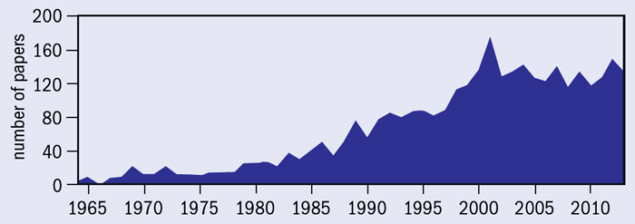
To make the observation, however, would require much larger numbers of B mesons than had been produced in previous experiments. Moreover, it would be necessary to have a precise measurement of the decay time, together with knowledge of the flavour of the B meson at production – that is, “flavour tagging”. To meet these challenges, several different designs were put forward, with the preferred solution being a high-luminosity asymmetrical e+e– collider, with a detector equipped with a silicon vertex detector and particle-identification capability. By colliding electrons and positrons at the centre-of-mass energy of the ϒ(4S) meson, the facilities could exploit the resonant production of quantum entangled B–B meson pairs, while the decay vertices of the two particles could be separated owing to the beam-energy asymmetry. Two such “B factories” were built – the PEP-II and KEKB accelerators, with their associated detectors BaBar and Belle, at SLAC in California and KEK in Japan, respectively. In 2001, the first results from the two experiments were enough to establish that CP is indeed violated in the B system (CERN Courier April 2001 p5).
By the time that the research programmes at the B factories had been completed, the accelerators had broken records for the highest instantaneous and integrated luminosities of any particle collider, allowing the measurement of the CP-violation parameter in B0 → J/ψ KS decays to be improved to a precision of better than 3%. This parameter is referred to as sin(2β), because it is sensitive to the angle β of the Cabibbo-Kobayashi-Maskawa (CKM) unitarity triangle, which represents in the complex plane the relation VudVub* + VcdVcb* + VtdVtb* = 0 between elements of the CKM quark-mixing matrix. Other measurements of the properties (angles and sides) of this triangle are all consistent, as figure 2 shows, where the constraints all overlap at the apex of the triangle. This astonishing agreement between data and theory led to the award of the 2008 Nobel Prize in Physics to Kobayashi and Maskawa.
The data represented in figure 2 are the result of enormous effort from experimentalists and theorists alike. Indeed, because the properties of quarks can be studied only through final states containing hadrons, detailed knowledge of the properties of the strong interaction specific to each interaction is necessary to obtain quantitative information about CP violation. In a few “golden modes”, such as the measurement of sin(2β), the associated uncertainties are negligible. But for others such as εK, input from, for example, lattice QCD calculations, is essential.
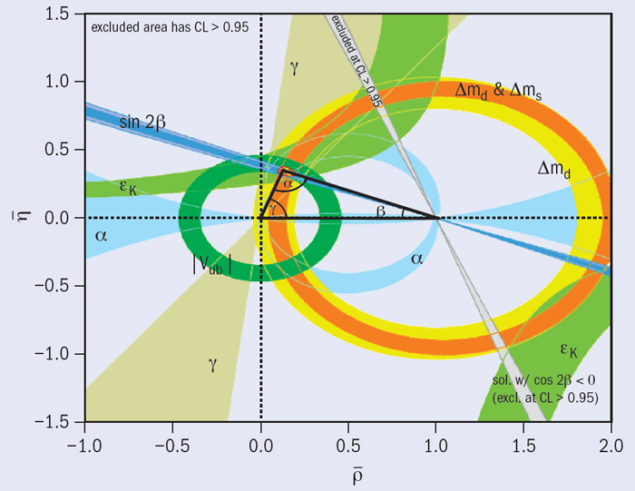
The large samples of B mesons available at BaBar and Belle allowed several further milestones in CP-violation studies to be achieved. One notable result is the observation of direct CP violation in B0 → Kπ decays (CERN Courier September 2004 p5). Further advances have become possible more recently because an even more copious source of b hadrons has become available – the LHC at CERN. In particular, the LHCb experiment is designed to exploit the potential for heavy-flavour physics at the LHC by instrumenting the forward region of proton–proton collisions, and therefore optimizing the acceptance of the b quark–antiquark pairs produced.
As with BaBar and Belle, LHCb is equipped with excellent vertexing and particle-identification capabilities. An additional challenge for an experiment at a hadron collider is the efficient rejection of minimum-bias events that occur at a high rate. This is achieved in LHCb by exploiting signatures of the decay products of heavy flavoured particles, such as muons with comparatively high transverse momentum and a secondary vertex that is significantly displaced from the proton–proton interaction point. Unlike the B factories, LHCb can study all types of b hadron – a feature that allowed it to make the first observation of direct CP violation in B0s meson decays (CERN Courier June 2013 p7). LHCb has also discovered very large – and rather puzzling – CP-violation effects in decays of B mesons to three particles (pions or kaons) (CERN Courier November 2012 p7), which need to be understood with further experimental and theoretical investigations.
Future prospects
What, then, remains for studies of CP violation? One important point is that the measurements shown in figure 2 are, on the whole, not limited by theoretical uncertainties. Because the consistency of the measurements provides strong constraints on theories of physics beyond the Standard Model, there is good motivation to continue to improve them. For example, the measurement of the angle γ achieved by studying CP-violation effects in B → DK decays has negligible theoretical uncertainty. The current constraint, combining results from BaBar, Belle and LHCb, gives an uncertainty of about ±10°. Reducing this uncertainty by an order of magnitude will either further constrain models that contain new sources of CP violation or, perhaps, reveal the presence of new physics. This is one of the main objectives of the next generation of B-physics experiments: the upgraded SuperKEKB accelerator and Belle2 detector at KEK, and the LHCb upgrade at CERN.
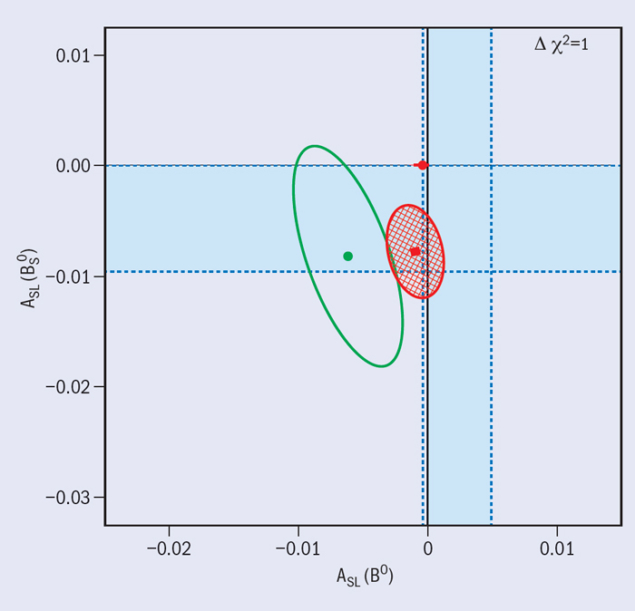
Image credit: Heavy Flavour Averaging Group, www.slac.stanford.edu/xorg/hfag/.
There are several other important CP-violating observables in the B system, where the Standard Model predicts small effects, but new physics could result in much larger values being measured in experiments. One good example is the decay mode B0s → J/ψ φ, which is the B0s sector equivalent of B0 → J/ψ KS, and probes a parameter labelled βs. In the Standard Model, βs is expected to be around 1°, whereas the latest results from LHCb and other experiments limit its value to less than about 4°. Similarly, the parameters describing CP violation in the B0– B0 (and B0s–B0S) mixing amplitudes, which are the B-system equivalents of εK, are expected to be vanishingly small. This has been a topic of considerable interest during the past few years, because the D0 experiment based at Fermilab’s Tevatron reported an anomalous charge asymmetry in events with two same-sign muons (CERN Courier July/August 2010 p6). These same-sign muons occur in events where both particles resulting from the hadronization of a b quark–antiquark pair decay semileptonically, but one of them decays only after oscillating into its antipartner. The inclusive asymmetry could, therefore, be caused by CP violation in either or both of the B0– B0 and B0s–B0S mixing amplitudes. However, measurements of the parameters describing CP violation in each of the two amplitudes individually do not reveal any discrepancy with the Standard Model, as figure 3 shows. Improved measurements are needed to resolve the situation and are eagerly anticipated.
Contemporary CP-violation searches are not confined to B mesons. Heavy-flavour experiments are abundant sources of charm hadrons, which can be used to investigate matter–antimatter asymmetries. Indeed, D0–D0 oscillations provide a particularly interesting “laboratory” for such searches, because this is the only system involving up quarks in which phenomena similar to those measured in the K0–K0 and B0–B0 systems can be probed. Within the Standard Model, the CP-violating effects are tiny, which provides a potential opportunity for new physics signatures to appear. The small mixing rates make these measurements extremely challenging, but experiments have now been able to establish the mixing phenomena at a high level of significance (CERN Courier November 2012 p7). Consequently, charm-physics experiments are becoming more focused on CP violation, and further progress can be foreseen as the accumulated data samples increase.
Because the top quark does not hadronize, it must be studied in different ways from the lighter heavy quarks. It is also, of course, an excellent tool for probing beyond the Standard Model. Among the many tests of the top sector being performed with the unprecedented samples collected by the ATLAS and CMS experiments are studies of CP violation in both the production and decays of top quarks. The discovery of a Higgs boson also provides the opportunity for ATLAS and CMS to search for CP violation in the Higgs sector, which is absent in the Standard Model.

Indeed, the description of CP violation within the context of the Standard Model is highly restrictive: it appears only among the flavour-changing interactions of the quarks. As a consequence, tests of CP violation in other sectors can be carried out with zero Standard Model background, and are therefore particularly sensitive to new sources of asymmetry. In addition to the examples given above, searches for nonzero electric dipole-moments of fundamental particles such as the electron are sensitive to flavour-conserving CP-violation effects. Owing to the amazingly high precision that is achieved in experiments, the measurements are sensitive to the small effects that are expected to be induced by new physics at the tera-electron-volt scale (Baron et al. 2014). As yet, however, there are no hints of a nonzero electric dipole-moment.
Perhaps the best chance of a discovery of a new source of CP violation in the medium-term future is in the lepton sector. Neutrino oscillations can be described by the Pontecorvo-Maki-Nakagawa-Sakata mixing matrix in an analogous way to the CKM matrix of the quark sector. (However, because the leptons do not couple to the strong interaction, the phenomenology of quark and lepton mixing is, in essentially all other respects, completely different.) The recent measurement of a nonzero value of the mixing angle θ13 by Daya Bay (CERN Courier April 2012 p8) and other experiments shows that all three flavours of neutrino mix with each other to give the physical eigenstates, which is a prerequisite for CP violation to be observable.
The parameter that describes CP violation in neutrino mixing, δCP, can be measured by comparing the probabilities for electron (anti)neutrino appearance in a muon (anti)neutrino beam. The MINOS experiment, which detects neutrino beams from Fermilab with a far detector at a baseline of 735 km in the Soudan mine in Minnesota, and the T2K experiment, which uses neutrinos from the Japan Proton Accelerator Complex (J-PARC) and a far detector 295 km away in the Kamioka mine, have already made first steps in this direction. Now the NOvA experiment is also under way in the US, using the upgraded beam at Fermilab with a baseline of 810 km (“NOvA takes a new look at neutrino oscillations”). However, far better sensitivity will be needed. For this reason, new and upgraded experiments have been proposed. These include the Long Baseline Neutrino Facility (“US particle-physics community sets research priorities”) in the US and Hyper-Kamkiokande (Hyper-K) in Japan, as well as possible projects in Europe and elsewhere. Example sensitivities to δCP in these experiments are shown in figure 4. Because the observation of CP violation in the lepton sector would give the possibility to explain the baryon asymmetry of the universe, through a mechanism known as leptogenesis, these projects are among the highest-priority science goals in the international particle-physics community. The construction and operation of such projects might take 20 years, but if CP violation is discovered in the lepton sector, it will be worth the wait.
Nonetheless, no one knows currently in which, if any, of these sectors the new sources of CP violation that must exist will appear first. It is therefore essential to continue to explore on as many fronts as possible. In this regard, it might be that the next big breakthrough in the field comes from the same particle that started the whole field off 50 years ago. Decays of kaons to final states containing a pion and a neutrino–antineutrino pair can provide a theoretically clean measurement of the height of the unitarity triangle, and therefore of the amount of CP violation described by the CKM matrix. Moreover, because these decays are highly suppressed, they are highly sensitive to physics beyond the Standard Model. Within the next few years, the NA62 experiment at CERN and the KOTO experiment at J-PARC will improve significantly on previous measurements of these decays, and might, therefore, start to provide hints of CP violation beyond the Standard Model. Such a discovery would provide fertile ground for investigations for the next 50 years.



